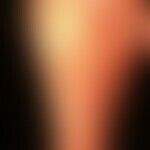HistoryThis section has been translated automatically.
Occurrence/EpidemiologyThis section has been translated automatically.
You might also be interested in
EtiopathogenesisThis section has been translated automatically.
LocalizationThis section has been translated automatically.
About 20% of children suffer from linear circumscritic scleroderma of the head (type "en coup de sabre" as well as the rare progressive facial hemiatrophy).
ClinicThis section has been translated automatically.
Linear circumscritic scleroderma of the en coup de sabre type and progressive facial hemiatrophy occur almost exclusively in early childhood. Unlike the other subtypes of circumscritic scleroderma, the course is slowly insidious and the active phase of the disease is usually much longer. Neurologic symptoms are common and may take the form of epileptic seizures, headaches, behavioral disturbances, and learning disabilities. Histologically, localized gliosis areas as well as perivascular inflammatory infiltrates could be found. Ophthalmologic changes are varied: uveitis, ocular muscle dysfunction, loss of eyebrows or alterations of the eyelids.
Juvenile linear circumscritic scleroderma of the extremities is characterized by a much more severe course than that of adults. It often results in skin and muscle atrophy, contractures of affected joints, shortening of extremities, and circumferential reductions. This often results in considerable functional, cosmetic and also psychological limitations in the affected patients. Furthermore, arthralgias and arthritides of the affected extremity are reported.
Disabling pansclerotic morphea, a very rare special form of generalized circumscritic scleroderma, usually manifests before the age of 14; rapid disease progression with obligate involvement of extracutaneous structures (subcutaneous adipose tissue, muscle, and bone) with severe growth retardation are the clinical features.
The limited form (mostly plaque type), the deep form (see below scleroderma, circumskripte) as well as eosinophilic fasciitis run a similar course as in adults.
LaboratoryThis section has been translated automatically.
Complication(s)(associated diseasesThis section has been translated automatically.
TherapyThis section has been translated automatically.
- In active linear circumscript scleroderma, an efficient systemic therapy should be initiated at the earliest possible time to stop the progression of the disease (avoidance of contractures, limb malpositions). This statement also applies to large circumscribed scleroderma.
- Accompanying physiotherapy (physiotherapy, manual lymph drainage) is important. Orthopaedic interventions (e.g. surgical corrections such as Achilles tendon lengthening or epiphysiodesis on the healthy leg to adjust a leg length difference) should only be carried out in the longer existing inactive stage of the disease.
- Cosmetic-aesthetic corrections in linear circumscript scleroderma of the type en coup de sabre and in progressive facial hemiatrophy are only advisable in the case of prolonged inactivity of the disease.
LiteratureThis section has been translated automatically.
- AWF Guideline (2008) Diagnosis and Therapy of Circumscript Scleroderma. Register number 013 - 066 Classification S1
Disclaimer
Please ask your physician for a reliable diagnosis. This website is only meant as a reference.







